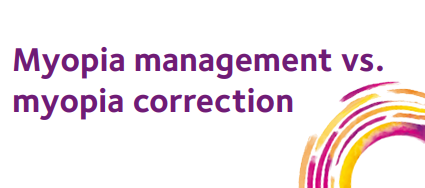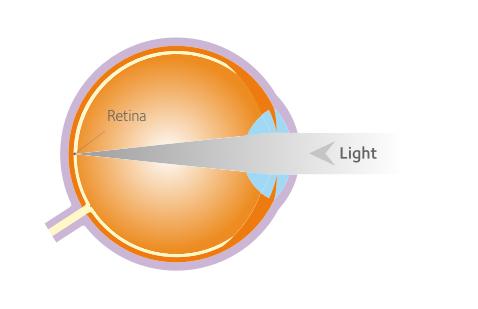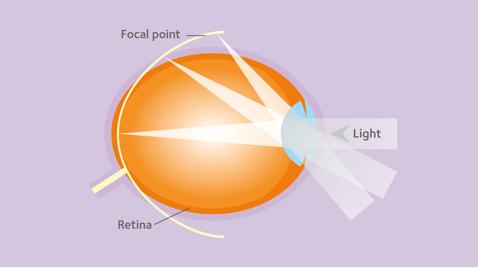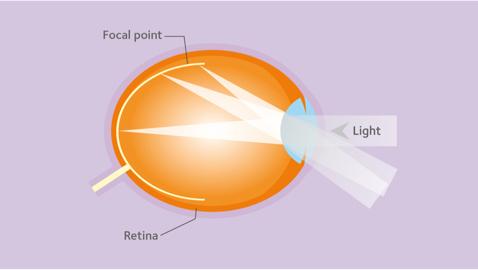

Myopia is traditionally corrected with standard spectacles or contact lenses by using the lenses to focus light rays on the macula to give clear distance vision. Light may also be refracted through standard spectacles or contact lenses, creating a scenario which may cause peripheral light rays to focus behind the retina – this phenomenon is sometimes called relative peripheral hyperopic defocus.
Typical Eye
Light focuses on the retina for a clear image.

Myopic Eye
As the eye continues to grow, myopia progresses and distance vision becomes more blurry.

Relative peripheral hyperopic defocus theory is thought by some to encourage eyeball growth; a consequence of which is increasing axial length and refractive error. Under-correction of myopia (which reduces the amount of peripheral hyperopic defocus) has been considered as a treatment to reduce myopic progression, but studies have shown that it has not been successful in slowing the speed of myopia progression.1 2 To read more about under-correction and un-correction, click here
Treatment of myopia

Traditional myopia correction:
Relative peripheral hyperopic defocus theory

Optical treatment of myopia:
Relative peripheral myopic defocus theory
Optical management of myopia
Optical management of myopia may rely on correcting the existing myopia and deliberately creating relative myopic defocus using the following methods:
Dual focus contact lenses

MiSight® 1 day with ActivControl™ technology is a soft, daily contact lens specifically designed for myopia control in children. It was the first soft contact lens granted approval with a CE mark specifically for the control of myopia in young myopic children and has been shown to reduce progression on average by around 60% over 3 years.
Ortho-Keratology

Ortho-Keratology lenses (also known as Ortho-K, corneal reshaping technology) are rigid lenses that are designed to be worn overnight. An Ortho-K lens is shaped to gently flatten the cornea to neutralise the prescription to correct myopia so that on waking, the lenses are removed and throughout the day, the child can see without contact lenses or glasses. The flattening of the cornea is currently believed to create a profile that may produce myopic defocus, which is thought to control axial length and therefore slow down the myopic progression.
Multifocal contact lenses

Some soft multifocal contact lenses have been shown by some researchers to achieve between 25% and 72% efficacy in clinical trials for controlling the speed of myopic progression.3 The ADD power of these multifocal contact lenses is believed to provide myopic defocus, which may help reduce the speed of myopia progression. Centre-distance multifocal contact lenses are widely available in a monthly replacement modality and are not currently approved for myopia control.
Spectacles

Progressive lenses, bifocals and specially designed spectacle lenses for myopia management may deliver a range of efficacy up to about 30%. New technology is constantly evolving in this area.
Advantages and disadvantages of different management options

Dual Focus (MiSight® 1 day)
Advantages
- CE cleared for the reduction of myopia progression in UK and therefore on-label prescribing
- Children adapt well to contact lenses
- No need to invest in additional equipment
Disadvantages
- Some ghosting may be noticeable
- Ongoing costs
- Risk of infection
Effect on control of myopia progression (sphere equivalent)3
59%

Soft multifocal contact lenses
Advantages
- Children adapt well to contact lenses
- No need to invest in additional equipment
- Wide prescription range can be treated
- Varied ADDs available
Disadvantages
- Some ghosting may be noticeable
- Ongoing costs
- Risk of infection
- Multifocal centre distance designs are currently off label
Effect on control of myopia progression (sphere equivalent)3
25%-72%

Orthokeratology
Advantages
- Freedom from any correction during the day
- Parents retain control
Disadvantages
- Some ghosting may be noticeable
- Ongoing costs
- Risk of infection
- Additional equipment and training required
- Only effective over a narrow prescription range
- Currently off- label prescribing for myopia control
Effect on control of myopia progression (sphere equivalent)3
30%-56%

Bifocal/Progressive Addition Spectacles
Advantages
- Easy and familiar
- Wide prescription range can be treated
Disadvantages
- May be cosmetically unattractive and therefore the child may not wear them to benefit from maximum treatment
Effect on control of myopia progression (sphere equivalent)3
11%-51%
Chung, K. & Mohidin, N. Undercorrection of myopia enhances rather than inhibit myopia progression. Vision Res. 42, 2555–2559 (2002)
Adler, D. & Millodot, M. The possible effect of undercorrection on myopic progression in children. Clin. Exp. Optom. 89, 315–321 (2006)
Sankaridurg P. Contact lenses to slow progression of myopia. Clinical and Experimental Optometry 2017 100(5) 432-437





